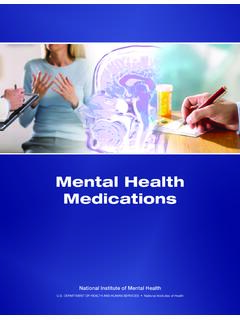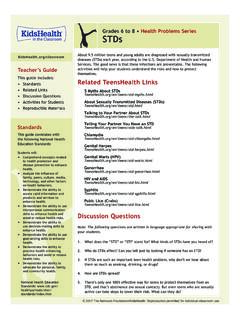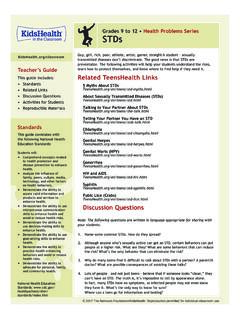Transcription of Bipolar Disorder in Children and Teens: A Parent's Guide
1 08265 Bipolar i08265 Bipolar i1/21/09 1:41:27 PM1/21/09 1:41:27 PM Bipolar Disorder in Children and teens : A Parent s Guide National Institute of Mental Health DEPARTMENT OF HEALTH AND HUMAN SERVICES National Institutes of HealthContentsWhat is Bipolar Disorder ? _____ 1 What are common symptoms of Bipolar Disorder in Children and teens ? _____ 1 What affects a child s risk of getting Bipolar Disorder ? _____ 3 How does Bipolar Disorder affect Children and teens differently than adults? _____ 4 How is Bipolar Disorder detected in Children and teens ? _____ 5 What illnesses often co-exist with Bipolar Disorder in Children and teens ? _____ 6 What treatments are available for Children and teens with Bipolar Disorder ?
2 _____ 7 Medications _____ 8 Psychotherapy _____ 15 What can Children and teens with Bipolar Disorder expect from treatment? _____ 16 Where can families of Children with Bipolar Disorder get help? _____ 17 Where can I go for help? _____ 18 What if my child is in crisis? _____ 18 Citations _____ 19 For more information on Bipolar Disorder _____ 2208265 Bipolar iii08265 Bipolar iii1/21/09 1:41:27 PM1/21/09 1:41:27 PM08265 Bipolar iv08265 Bipolar iv1/21/09 1:41:27 PM1/21/09 1:41:27 PM All parents can relate to the many changes their kids go through as they grow up. But sometimes it s hard to tell if a child is just going through a phase, or perhaps showing signs of something more serious.
3 Recently, doctors have been diagnosing more Children with Bipolar Disorder ,1 sometimes called manic-depressive illness. But what does this illness really mean for a child? This booklet is a Guide for parents who think their child may have symptoms of Bipolar Disorder , or parents whose child has been diagnosed with the illness. This booklet discusses Bipolar Disorder in Children and teens . For information on Bipolar Disorder in adults, see the National Institute of Mental Health (NIMH) booklet Bipolar Disorder . 08265 Bipolar Sec1:108265 Bipolar Sec1:11/21/09 1:41:28 PM1/21/09 1:41:28 PM What is Bipolar Disorder ? Bipolar Disorder , also known as manic-depressive ill-ness, is a brain Disorder that causes unusual shifts in mood and energy.
4 It can also make it hard for some-one to carry out day-to-day tasks, such as going to school or hanging out with friends. Symptoms of Bipolar Disorder are severe. They are different from the normal ups and downs that everyone goes through from time to time. They can result in damaged relationships, poor school performance, and even suicide. But Bipolar Disorder can be treated, and people with this illness can lead full and productive lives. Bipolar Disorder often develops in a person s late teens or early adult years, but some people have their first symptoms during childhood. At least half of all cases start before age What are common symptoms of Bipolar Disorder in Children and teens ? Yo u t h w i t h b i p o l a r d i s o r d e r e x p e r i e n c e u n u s u -ally intense emotional states that occur in distinct periods called mood episodes.
5 An overly joyful or overexcited state is called a manic episode, and an extremely sad or hopeless state is called a depressive episode. Sometimes, a mood episode includes symptoms of both mania and depression. This is called a mixed state. People with Bipolar Disorder also may be explosive and irritable during a mood episode. Extreme changes in energy, activity, sleep, and behavior go along with these changes in mood. Symptoms of Bipolar Disorder are described on the following page. Bipolar Disorder in Children and teens : A Parent s Guide 1 08265 Bipolar Sec1:208265 Bipolar Sec1:21/21/09 1:41:28 PM1/21/09 1:41:28 PM Symptoms of mania include: Mood Changes Being in an overly silly or joyful mood that s unusual for your child.
6 It is different from times when he or she might usually get silly and have fun. Having an extremely short temper. This is an irritable mood that is unusual. Behavioral Changes Sleeping little but not feeling tired talking a lot and having racing thoughts Having trouble concentrating, attention jumping from one thing to the next in an unusual way talking and thinking about sex more often Behaving in risky ways more often, seeking pleasure a lot, and doing more activities than usual. Symptoms of depression include: Mood Changes Being in a sad mood that lasts a long time Losing interest in activities they once enjoyed Feeling worthless or guilty. Behavioral Changes Complaining about pain more often, such as headaches, stom-ach aches, and muscle pains Eating a lot more or less and gain-ing or losing a lot of weight Sleeping or oversleeping when these were not problems before Losing energy Recurring thoughts of death or suicide.
7 It s normal for almost every child or teen to have some of these symptoms some-times. These passing changes should not be confused with Bipolar Disorder . Symptoms of Bipolar Disorder are not like the normal changes in mood and energy that everyone has now and then. Bipolar symptoms are more extreme and tend to last for most of the day, nearly every day, for at least one week. Also, depressive or manic episodes include moods very different from a child s normal mood, and the behaviors described in the chart above may start at the same time. Sometimes the symptoms of Bipolar Disorder are so severe that the child needs to be treated in a hospital. 2 National Institute of Mental Health 08265 Bipolar Sec1:308265 Bipolar Sec1:31/21/09 1:41:28 PM1/21/09 1:41:28 PM In addition to mania and depression, Bipolar Disorder can cause a range of moods, as shown on the scale below.
8 One side of the scale includes severe depression, moderate depression, and mild low mood. Moderate depression may cause less extreme symptoms, and mild low mood is called dysthymia when it is chronic or long-term. In the middle of the scale is normal or balanced mood. normal or balanced mood severe depression, moderate depression, and mild low mood hypomania and severe mania Sometimes, a child may have more energy and be more active than normal, but not show the severe signs of a full-blown manic episode. When this happens, it is called hypomania, and it generally lasts for at least four days in a row. Hypomania causes noticeable changes in behavior, but does not harm a child s ability to func-tion in the way mania does.
9 What affects a child s risk of getting Bipolar Disorder ? Bipolar Disorder tends to run in families. Children with a parent or sibling who has Bipolar Disorder are four to six times more likely to develop the illness, compared with Children who do not have a family history of Bipolar However, most Children with a family history of Bipolar Disorder will not develop the illness. Compared with Children whose parents do not have Bipolar Disorder , Children whose parents have Bipolar Disorder may be more likely to have symp-toms of anxiety disorders and attention deficit hyperactivity Disorder (ADHD).4 Several studies show that youth with anxiety disorders are more likely to develop Bipolar Disorder than youth without anxiety disorders .
10 However, anxiety disorders are very common in young people. Most Children and teens with anxiety disorders do not develop Bipolar , 6 Bipolar Disorder in Children and teens : A Parent s Guide 3 08265 Bipolar Sec1:408265 Bipolar Sec1:41/21/09 1:41:28 PM1/21/09 1:41:28 PM At this time, there is no way to prevent Bipolar Disorder . NIMH is currently study-ing how to limit or delay the first symptoms in Children with a family history of the illness. Also see the section in this booklet called What illnesses often co-exist with bipo-lar Disorder in Children and teens ? How does Bipolar Disorder affect Children and teens differently than adults? Bipolar Disorder that starts during childhood or dur-ing the teen years is called early-onset Bipolar Disorder .





